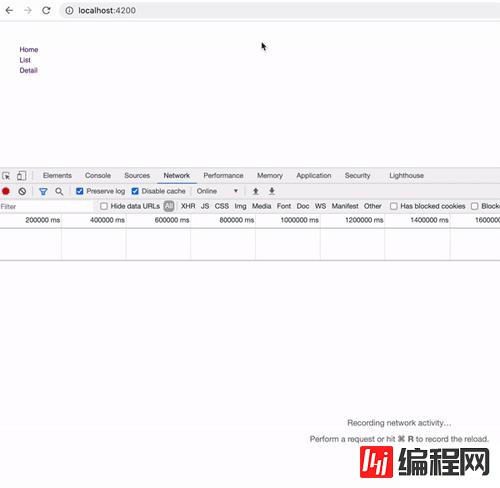本篇内容主要讲解“angular路由中的懒加载、守卫、动态参数是什么意思”,感兴趣的朋友不妨来看看。本文介绍的方法操作简单快捷,实用性强。下面就让小编来带大家学习“Angular路由中的懒加载、守卫、动态参
本篇内容主要讲解“angular路由中的懒加载、守卫、动态参数是什么意思”,感兴趣的朋友不妨来看看。本文介绍的方法操作简单快捷,实用性强。下面就让小编来带大家学习“Angular路由中的懒加载、守卫、动态参数是什么意思”吧!
Angular可以根据路由,动态加载相应的模块代码,这个功能是性能优化的利器。
为了加快首页的渲染速度,我们可以设计如下的路由,让首页尽量保持简洁、清爽:
const routes: Routes = [
{
path: '',
children: [
{
path: 'list',
loadChildren: () => import('./components/list/list.module').then(m => m.ListModule),
},
{
path: 'detail',
loadChildren: () => import('./components/detail/detail.module').then(m => m.DetailModule),
},
...
],
},
];首页只有一些简单的静态元素,而其他页面,比如列表、详情、配置等模块都用loadChildren动态加载。
效果如下:

其中的components-list-list-module-ngfactory.js文件,只有当访问/list路由时才会加载。
当我们访问或切换路由时,会加载相应的模块和组件,路由守卫可以理解为在路由加载前后的钩子,最常见的是进入路由的守卫和离开路由的守卫:
canActivate 进入守卫
canDeactivate 离开守卫
比如我们想在用户进入详情页之前,判断他是否有权限,就可以使用canActivate守卫。
{
path: 'detail',
loadChildren: () => import('./components/detail/detail.module').then(m => m.DetailModule),
// 路由守卫
canActivate: [AuthGuard],
},使用CLI命令创建路由守卫模块:
ng g guard authauth.guard.ts
import { Injectable } from '@angular/core';
import { CanActivate, ActivatedRouteSnapshot, RouterStateSnapshot, UrlTree } from '@angular/router';
import { Observable } from 'rxjs';
import { DetailService } from './detail.service';
@Injectable({
providedIn: 'root'
})
export class AuthGuard implements CanActivate {
constructor(
private detailService: DetailService,
) {}
canActivate(
route: ActivatedRouteSnapshot,
state: RouterStateSnapshot): Observable<boolean | UrlTree> | Promise<boolean | UrlTree> | boolean | UrlTree {
return new Observable(observer => {
// 鉴权数据从后台接口异步获取
this.detailService.getDetailAuth().subscribe((hasPermission: boolean) => {
observer.next(hasPermission);
observer.complete();
});
});
}
}获取权限的service:
ng g s detaildetail.service.ts
import {Injectable} from '@angular/core';
import { HttpClient } from '@angular/common/http';
@Injectable({ providedIn: 'root' })
export class DetailService {
constructor(
private http: HttpClient,
) { }
getDetailAuth(): any {
return this.http.get('/detail/auth');
}
}效果如下:

由于我们对/detail路由增加了守卫,不管是从别的路由切换到/detail路由,还是直接访问/detail路由,都无法进入该页面。
在路由中带参数有很多中方法:
在path中带参数
在queryString中带参数
不通过链接带参数
{
path: 'user/:id',
loadChildren: () => import('./components/user/user.module').then(m => m.UserModule),
},html传参
<a [routerLink]="['/list']" [queryParams]="{id: '1'}">...</a>ts传参
this.router.navigate(['/list'],{ queryParams: { id: '1' });注意:通过data传递的路由参数只能是静态的
{
path: 'detail',
loadChildren: () => import('./components/detail/detail.module').then(m => m.DetailModule),
// 静态参数
data: {
title: '详情'
}
},data只能传递静态参数,那我想通过路由传递从后台接口获取到的动态参数,该怎么办呢?
答案是通过resolve配置。
{
path: 'detail',
loadChildren: () => import('./components/detail/detail.module').then(m => m.DetailModule),
// 动态路由参数
resolve: {
detail: DetailResolver
},
},detail.resolver.ts
import { Injectable } from '@angular/core';
import { Resolve, ActivatedRouteSnapshot, RouterStateSnapshot } from '@angular/router';
import { DetailService } from './detail.service';
@Injectable({ providedIn: 'root' })
export class DetailResolver implements Resolve<any> {
constructor(private detailService: DetailService) { }
resolve(route: ActivatedRouteSnapshot, state: RouterStateSnapshot): any {
return this.detailService.getDetail();
}
}detail.service.ts
import {Injectable} from '@angular/core';
import { HttpClient } from '@angular/common/http';
@Injectable({ providedIn: 'root' })
export class DetailService {
constructor(
private http: HttpClient,
) { }
getDetailAuth(): any {
return this.http.get('/detail/auth');
}
// 增加的
getDetail(): any {
return this.http.get('/detail');
}
}创建组件
ng g c detialdetail.component.ts
import { Component, OnInit } from '@angular/core';
import { ActivatedRoute } from '@angular/router';
@Component({
selector: 'app-detail',
templateUrl: './detail.component.html',
styleUrls: ['./detail.component.sCSS']
})
export class DetailComponent implements OnInit {
constructor(
private route: ActivatedRoute,
) { }
nGonInit(): void {
// 和获取静态参数的方式是一样的
const detail = this.route.snapshot.data.detail;
console.log('detail:', detail);
}
}到此,相信大家对“Angular路由中的懒加载、守卫、动态参数是什么意思”有了更深的了解,不妨来实际操作一番吧!这里是编程网网站,更多相关内容可以进入相关频道进行查询,关注我们,继续学习!
--结束END--
本文标题: Angular路由中的懒加载、守卫、动态参数是什么意思
本文链接: https://lsjlt.com/news/69605.html(转载时请注明来源链接)
有问题或投稿请发送至: 邮箱/279061341@qq.com QQ/279061341
2022-06-04
2022-06-04
2022-06-04
2022-06-04
2022-06-04
2022-06-04
2022-06-04
2022-06-04
2022-06-04
2022-06-04
回答
回答
回答
回答
回答
回答
回答
回答
回答
回答
0